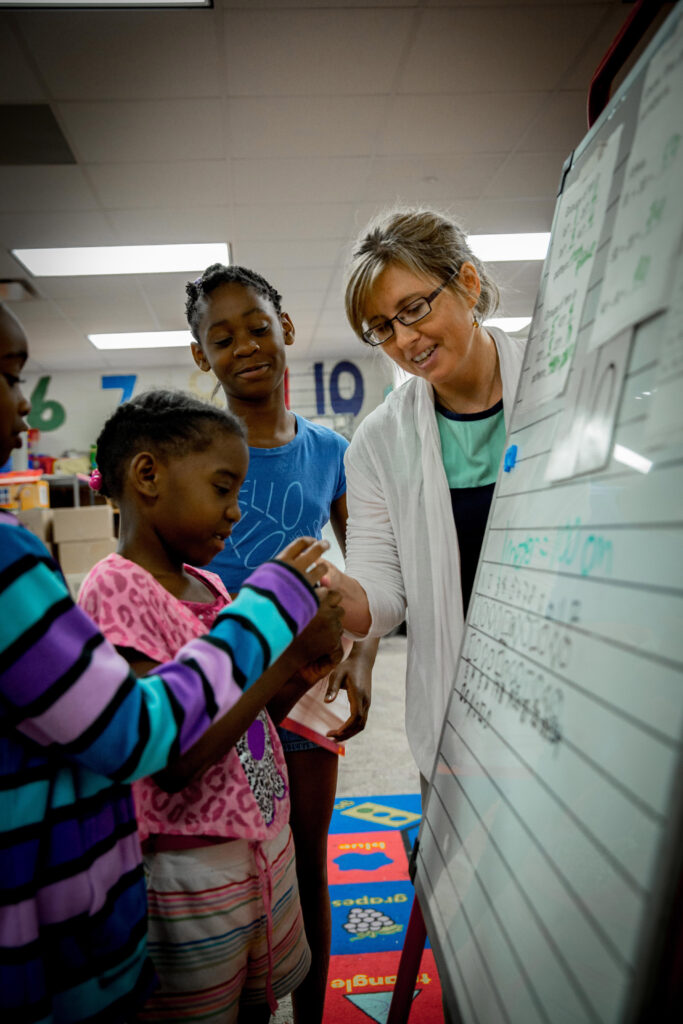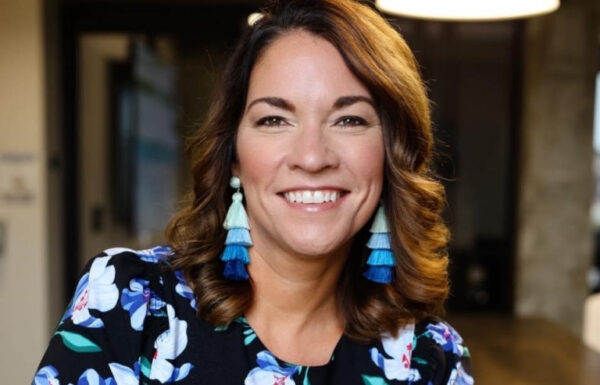A Letter from CICF's CEO | "Our Regional Commitment: CICF’s New Strategic Plan"
In this letter marking her two-year anniversary as CEO, Jennifer Bartenbach shares CICF’s new vision and strategic plan for Central Indiana. She outlines the region’s significant potential, the critical role of the nonprofit sector—which contributes $43 billion annually and employs 1 in 10 private-sector workers—and CICF’s commitment to being a trusted partner through it all. With a goal to make Central Indiana the most connected, philanthropic, and impactful community in the country, CICF is stepping forward with a plan.

Written by Jennifer Bartenbach, CEO of CICF
Today, we are proud to unveil the Central Indiana Community Foundation’s new strategic plan. Before I give an overview, I’d like to briefly reintroduce our organization. CICF is pretty unusual, even among community foundations, so I know it can be helpful to clarify who we are and what we do.
CICF works across Central Indiana to distribute philanthropy, support nonprofits, and unite communities around our biggest challenges in pursuit of a stronger region.
Practically, that means we help philanthropists identify and give money to effective nonprofits; we also offer administrative and financial services to various foundations, funds, and nonprofits. Through our services, those who give and those who serve are able to focus more intently on their missions.
CICF is just one part of the larger CICF Collaborative, which includes four additional cornerstone entities:
- Hamilton County Community Foundation
- IMPACT Central Indiana
- Indianapolis Foundation
- Women’s Fund of Central Indiana
Each of these entities operates independently while CICF provides them with shared services such as finance, HR, marketing, IT, or philanthropy support.
As CEO for two years now, it has been my job to renew CICF’s mission, vision, and the strategic plan we unveil today. But make no mistake, the final product is the result of deep consultation with community members, CICF staff and board, and our fellow CICF Collaborative entities.
CICF’s ultimate mission is to build a community of opportunity, no matter place, race, or identity.
The vision we hold to achieve that mission is of a Central Indiana that is the most connected, philanthropic, and impactful region in the nation.
I know that sounds pretty lofty, but as a growing population center, Central Indiana is also one of the fastest-growing economic engines in the Midwest. Our nonprofit sector is a critical part of that success, responsible for more than $44 billion in annual economic activity and employing 10% of our private sector workforce.
Let’s not downplay it. Instead, I believe we can more efficiently bring that success to bear on the challenges in our region’s communities.
I fully recognize this is an era of challenge—political, social, and economic.
That certainly includes the nonprofit sector, where some have laid off staff, reduced services, or even censored communication in an effort to navigate evolving restrictions around targeted service to vulnerable communities.
We cannot minimize those real and persistent challenges. However, left in the wake of this upheaval, I also feel funders and nonprofits have a generational opportunity to showcase the power of the renowned Hoosier nonprofit sector.
Having worked twelve years at the region’s preeminent nonprofit convener, I know Central Indiana has the pieces. It’s time we put them together.
Our new plan identifies four pathways to achieve a more complete, welcoming, and broadly prosperous region:
Strengthen Regional Connectivity
In just the last several years, Indiana has grown in ways we haven’t seen in decades. The vast majority of that growth was in Central Indiana counties.
While Indianapolis has long been seen as a prime economic driver of the overall state, the same is increasingly true of the larger metro region. In fact, for the first time in history, Marion County’s eight surrounding counties now have a larger combined population than the central county.
Though our communities remain distinct—rural, urban, and suburban—they are also unified by a regional identity; we might live in Greenfield, work in Indy, shop in Carmel, and have a kid who attends Franklin College. Every time we cross city limits or county lines, we’re part of the social and economic web of a regional community.
Many of the biggest challenges and opportunities our communities face are also interconnected—housing affordability, workforce development, transportation, immigration, hunger, and a more resilient infrastructure, just to name a few.
While local foundations and nonprofits will remain the experts in their communities, regional collaboration attracts more attention from funders, accesses more state and federal resources, and can even utilize more comprehensive data.
A recent example of that approach is the hunger study currently underway in all nine Central Indiana counties. Previously, the Indy Hunger Network conducted an annual survey of food insecurity in Marion County. However, anyone working in food access in surrounding counties will tell you this problem goes well beyond one city. CICF funded the study’s expansion to get a better sense of the full regional need.
The data collected will be important for nonprofits applying for grants to help deliver more food access at a time of growing food insecurity in our region.
Inspire and Enhance Giving
As a region that has long been home to some of the nation’s largest philanthropic entities, we can sometimes take for granted what philanthropy is and what it does well. Philanthropy, at its best, serves as a bridge or catalyst to address gaps left by the public or private sector.
And though the philanthropic sector is not large enough to fully replace either, it has long been an option Hoosiers rely on to bolster human services and enhance cultural amenities.
However, too many assume that only millionaires and billionaires can participate. Meanwhile, younger generations are increasingly skeptical of the practice altogether. CICF will show more residents that anybody can be a philanthropist. We will create new channels for giving that accommodate different financial capacities and interests while showing how philanthropic participation is a singularly effective way to participate in, learn about, and serve your community.
Support and Strengthen Nonprofits
The nonprofit ecosystem refers to the network of charitable organizations, foundations, related government agencies, businesses, and communities who are working together to effect change.
I am convinced this ecosystem works best when it operates through collaboration and shared resources.
In isolation, nonprofits face limited funding, capacity needs, administrative burdens, and competition. When they partner with a larger network such as the CICF Collaborative, they can leverage our administrative infrastructure. But that exchange doesn’t always have to be a formal service or involve money at all.
For example, CICF’s recent office hours have freely provided area nonprofits an opportunity to visit (in person or virtually) with CICF staff or staff of other entities in the CICF Collaborative. These consultations have touched on everything from informal legal advice, uncovering eligible tax exemptions, or even help installing a “donate” button on an organization’s website.
Collaborations like these can elevate the total impact of Central Indiana’s nonprofit sector.
Invest in People
Our final pathway concerns the investment CICF makes into those doing the work—including the staff here at CICF.
To achieve the kind of results our region needs, we need smart people who feel supported, connected, and healthy.
We are working to model best employment practices while offering services and training for other area nonprofits who want to better support an effective team.
Recently, I was asked what has kept me at CICF for 12 years.
I have learned that sustainable, positive change takes time. Deep learning takes time. Building a strong coalition takes time. Addressing large problems in a meaningful way takes time.
To some, it may sound like an argument against urgency. But urgency is fundamental; urgency drives us. However, it can be fleeting without commitment. And that is what has kept me at CICF.
Commitment is the one thing we absolutely need to create lasting change. CICF is not bound by a fiscal year or an election cycle. When economic winds shift or the political pendulum swings, our commitment to a more broadly prosperous Central Indiana remains.
Because ultimately, Central Indiana is our community, too. For me, it is where I’ve started a career, made a home, and raised a family. This region has been the setting and the catalyst for the most rewarding and fulfilling experiences of my life. I believe that when more of our neighbors have similar opportunities to thrive, Central Indiana is an even better place for my family to live.
With our new strategic plan, CICF commits to working urgently, selflessly, and tirelessly to make that happen; we commit to the nonprofits and community members working alongside us.
Most importantly, we invite and welcome the commitment of anyone who recognizes the opportunity we have to galvanize this region’s philanthropic and nonprofit sectors like never before; donors looking for newer, bolder, and more impactful ways to give; organizations wanting to help make a bigger impact through partnership; local leaders in business and government who want to use their powerful influence to improve the services that benefit those they employ and represent.
Join us in a renewed commitment to a better Central Indiana for all.
Finally, I invite you to watch CICF’s new video celebrating the potential of central Indiana.

